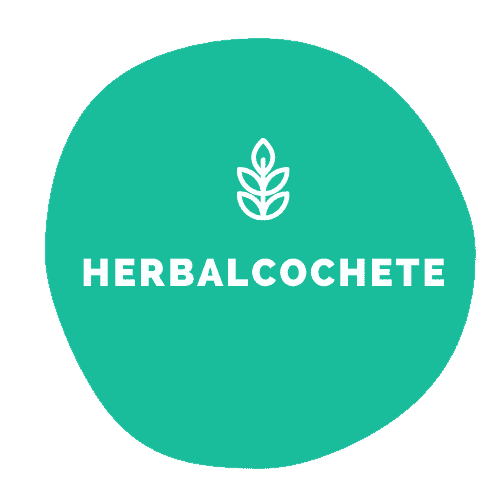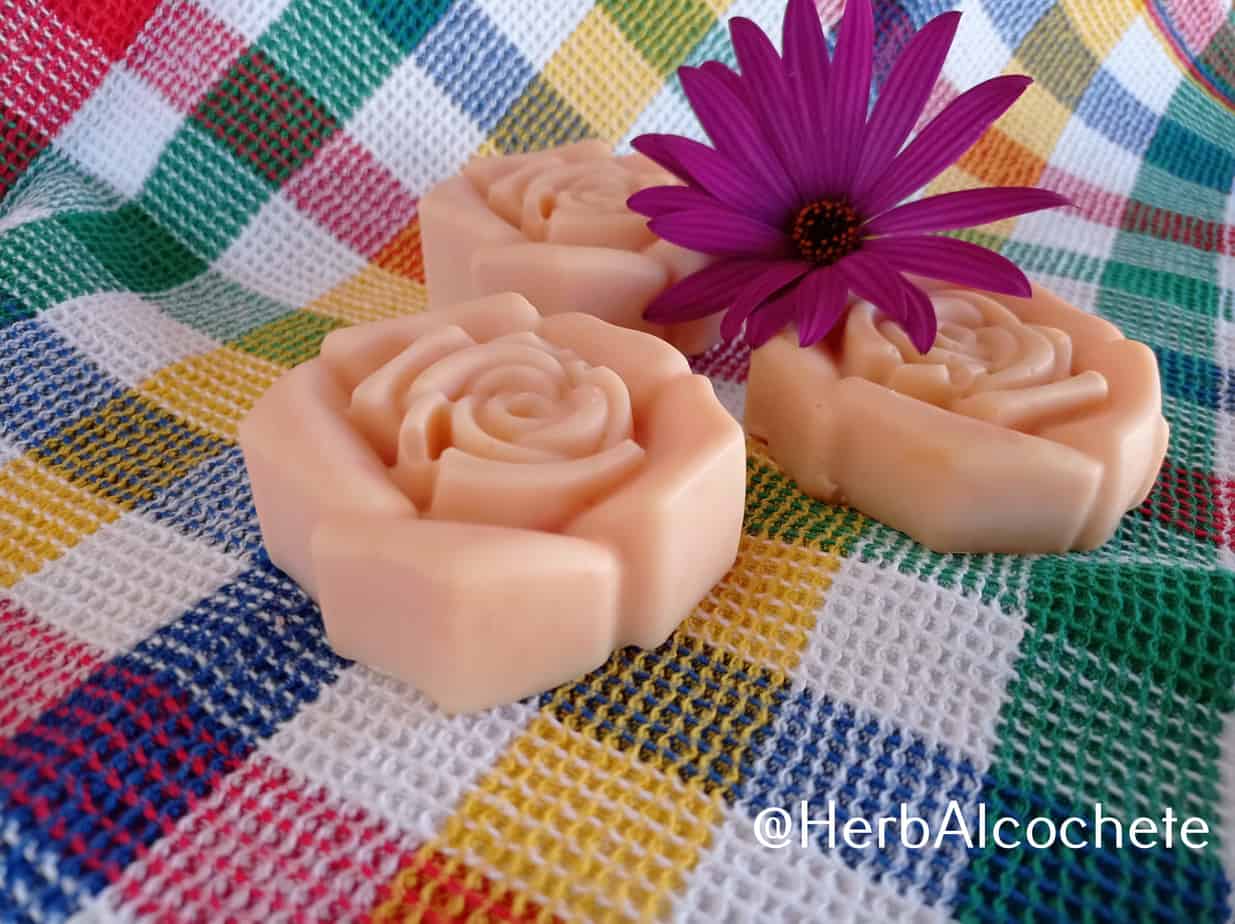Do you like this beautiful rosy-orange soap, colored with turmeric and scented with ylang-ylang? It makes for an exotic soap with no particularly special ingredient. Try this turmeric and ylang-ylang soap recipe at home, you’ll love it!
Table of Contents
- What Is Ylang-Ylang?
- Turmeric as a Natural Colorant
- Turmeric and Ylang-Ylang Soap Recipe
- Find Where To Buy Handmade Ylang-Ylang Soap
- How To Use This Soap
- Related Posts
- Watch This Video About Safety
- Cold Process Soap Making Tutorial Video
- Cold Process Soap Making Lessons
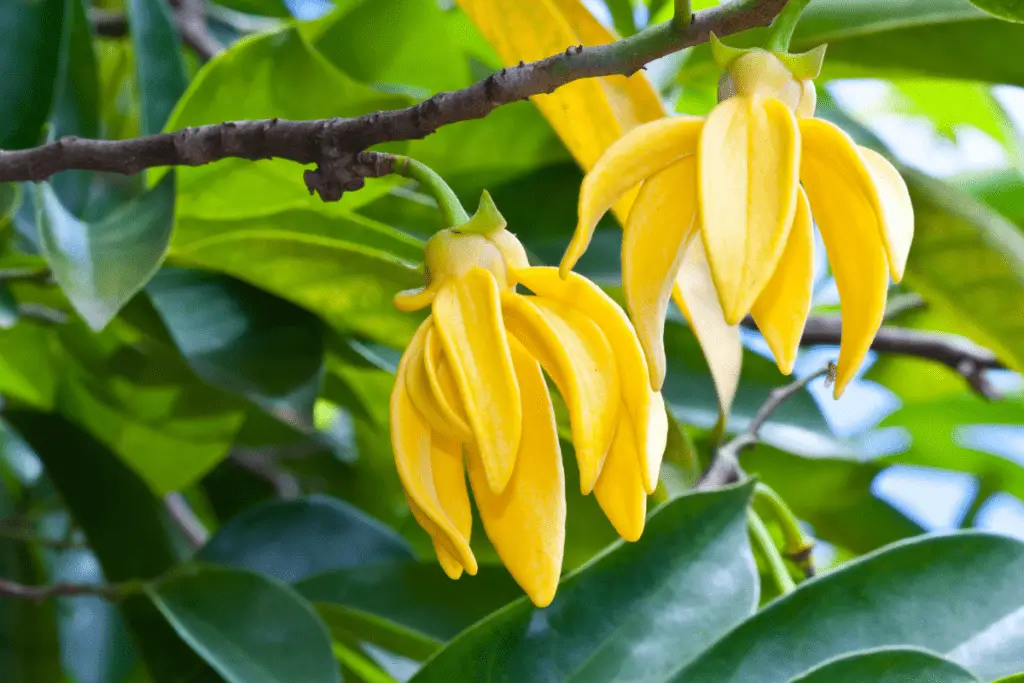
What Is Ylang-Ylang?
Ylang-ylang is a pretty fragrant yellow flower that comes from a tropical tree, native from India – Cananga Odorata. In Indonesia, ylang-ylang flowers are spread on the bed of newlyweds, while in Philippines they are strung into necklaces for religious ceremonies.
But its main usage is definitely in perfumery, as an essential oil. It is widely used for oriental- or floral-themed perfumes (such as Chanel No. 5). Ylang-ylang fragrance is rich and bright with hints of jasmine and neroli, thus it is sometimes described as heavy, sweet, and carries a slightly fruity floral scent. It is somehow overpowering, but blends well with most fruit, floral and wood scents.
I’ve blended ylang-ylang for this soap with cedarwood, to work as a scent fixer and an additional woody note. The final scent is soft and very floral.
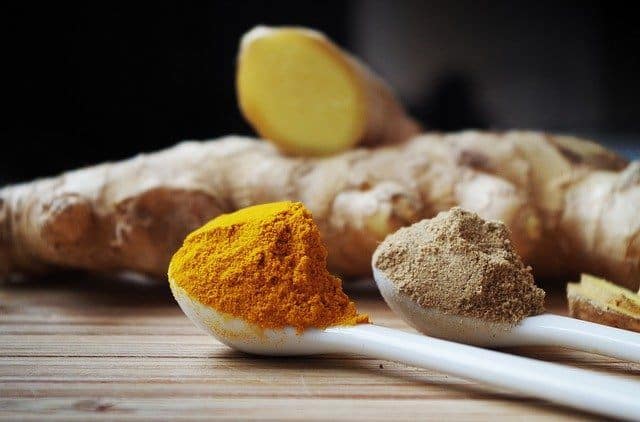
Turmeric as a Natural Colorant
This is not the first time I use turmeric as a natural colorant. The first turmeric soap I’ve made, got a pretty caramel color, but it was not similar to the orange-pink I’ve got this time.
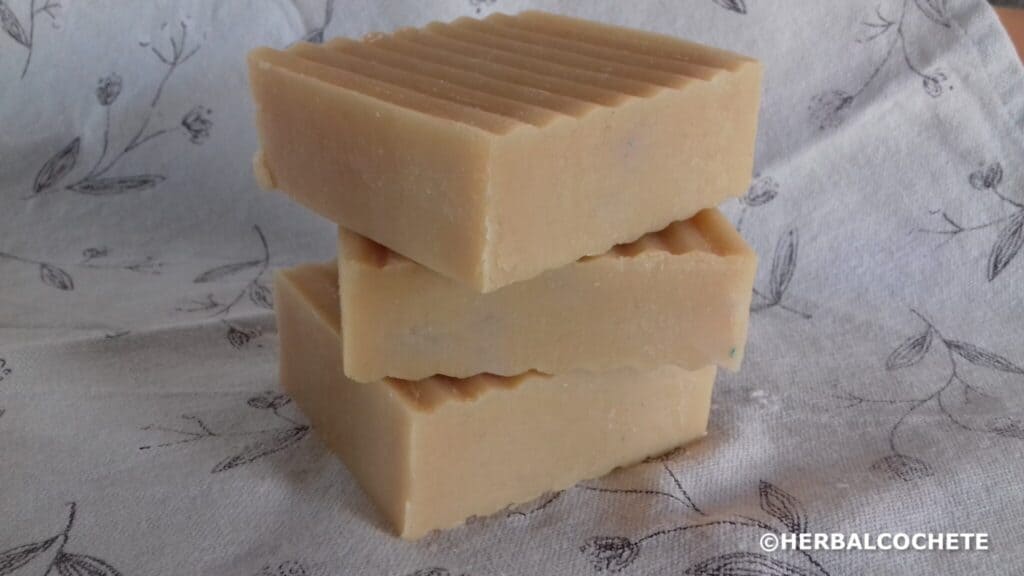
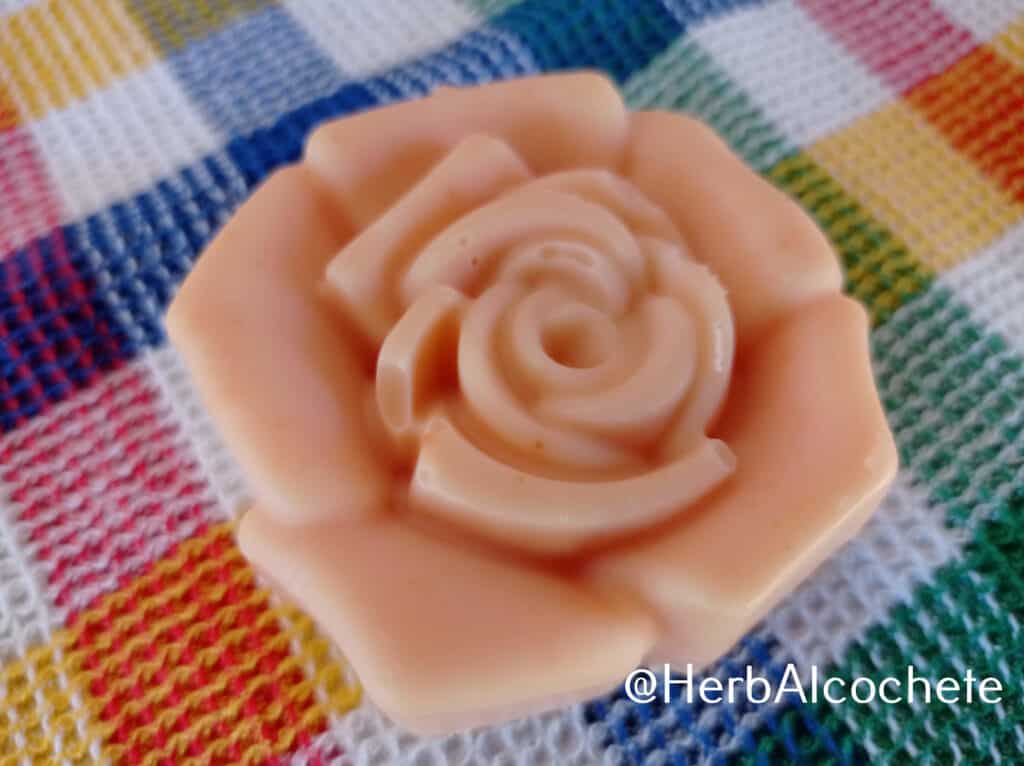
The different color might have come from one or many of those factors together: using the turmeric in lye water; using a different oils mixture (with olive oil); using cinnamon essential oil; using a different turmeric brand.
I didn’t mind the different color – I was aiming at having orange – as it was pretty anyway, and I do like this “natural” effect of impredicability. But I was pretty satisfied this time to get the orange color I wanted. Or at least closer to what I’ve wanted. The pinky-orange is quite beautiful, and is a better colorant for light pink than the pink clay I usually use.
When you mix the turmeric with the soap batter, while reaching trace, the soap gets a vibrant orange color that fades to light pink after hardening and curing.
Turmeric and Ylang-Ylang Soap Recipe
This soap uses an oil mixture from another recipe, with no coconut oil and no olive oil. Olive oil and coconut oil are must-have’s in any handmade soap recipe. But do they really have to be there? No, you can make soap with any oil mixture. And this soap is the proof.
It uses palm oil at 50% as the hard oil content and the rest is a mixture of soft oils, respecting maximum quantities to keep the soap hard enough.
Naturally colored with turmeric and scented with ylang-ylang and cedarwood essential oils.
Find Where To Buy Handmade Ylang-Ylang Soap
Still not inspired to make your own soap at home? But you do wish to use or give it a try at handmade ylang-ylang soap. You can find a few options online to buy handmade ylang-ylang soap below:
- Ylang-Ylang Handmade Soap (Etsy)
- Ylang-Ylang Lavender Handmade Soap (Etsy)
- Ylang-Ylang Goddess Soap (Etsy)
Ylang-Ylang Lavender Handmade Soap (Etsy)
How To Use This Soap
In the shower or bath, wet your hands and rub your soap in them to create a lather. Wash your hands first, then repeat the process and apply soap to your whole body using the soap directly and your hands. You may also wash your face with it. Rinse hands and body abundantly. Also wash your soap from lather before placing it in your soap dish or bag saver.
Washcloths and sponges should be avoided. Avoid washing your intimate zone and your hair, soap pH in not adequate for those parts of your body. Avoid eye contact with soap to prevent stinging. Make a patch test before using your soap. Stop using your soap if you feel any immediate adverse reaction in your skin (red skin, rashes, itching).
To take best advantage of your handmade soap (made by yourself or store-bougth), read How Do You Use Handmade Soap?
Related Posts
Ingredients and Recipes
- Vegetable oils: Oil Properties For Soap Making
- Essential oils: Best Essential Oils for Soap Making
- Colorants: How To Color Your Soap With Kitchen Ingredients
- Beginner Recipes: Soap Recipes for Beginners
- Cold Process Soap Recipes: Free Cold Process Soap Recipes
Soap Making Techniques and Troubleshooting
- Cold Process Tutorial Guide: Learn To Make Cold Process Soap?
- Soap Making Methods: How To Make Soap At Home
- Soap Making Trace: Know Everything About Trace in Soap Making
- Soap Acceleration: Causes, How To Avoid It Or How To Fix It
- Soda Ash In Soap: What It Is, How to Remove It
Watch This Video About Safety
Cold Process Soap Making Tutorial Video
Cold Process Soap Making Lessons
The tutorials in this blog are a great – and free! – help to start with cold process soap making. Practice is the next step to harness the art of making soaps at home. However, I understand if you prefer to have some formal lessons, where you will feel more supported with the steps. Feel free to join these courses at Udemy.
Equipment
Ingredients
Lye Water
- 175 g distilled water
- 58 g lye (100% sodium hydroxide)
Oils/Fat
- 243 g RSPO palm oil
- 45 g castor oil
- 72 g sunflower oil
- 45 g sweet almond oil
- 18 g avocado oil
- 27 g grapeseed oil
- 1 tsp turmeric
Add After Trace
- 8 drops grapefruit seed extract (GSE) (anti-oxidant)
- 13 ml essential oils blend or other (optional)
- alcohol or witch hazel to sprinkle recommended to avoid soda ash
Essential Oils Blend
Instructions
Get Ready!
- Wear goggles and gloves! Look at “Safety Precautions” in the video above or in Soap Making Safety Precautions
- Watch the video above about "Cold Process Soap Making Tutorial" or read the post Learn To Make Cold Process Soap for instructions on cold process soap making before starting. These are generic but important steps for all recipes.
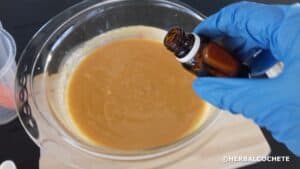
- Assemble everything: ingredients, equipment, safety equipment. Prepare your workstations. Measure all the ingredients. Don’t start the recipe without having everything ready!
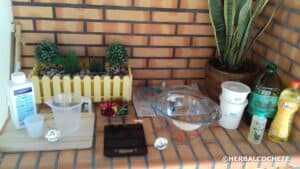
- After measuring your oils, remove 1 tbsp of liquid oil and mix it well with the paprika. Avoid clumps.
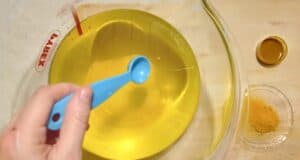
Heat the Oils
- Heat all your oils in a pyrex bowl at the microwave until the palm oil melts. Use 1 min periods and check temperature. The oils shouldn't overheat (> 60ºC or 140ºF)
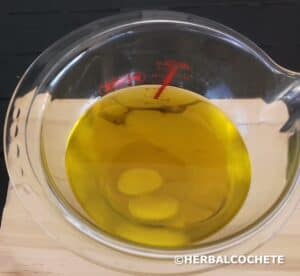
Make the Lye Water
- Make the lye solution according to How To Make Lye Water. Mix it until the vapors start to dissipate. Add the dried petals at the end.
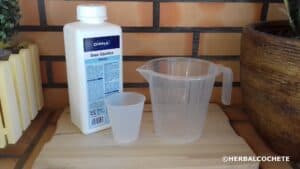
Make the Soap Batter
- Use as target temperature 38ºC for the oil-solution mixture. It can be less than this. The lye and oils should not have a difference of more than 10º between them.
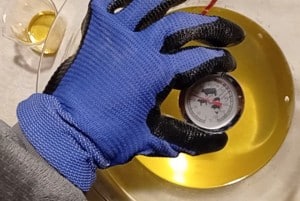
- Start mixing with the immersion blender. Add the oil with turmeric.
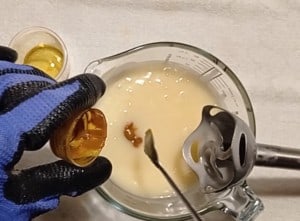
- Reach trace with the immersion blender. You will see the soap turning into a bright orange. Later, while the soap sets and cures, it will fade to rosy-orange.
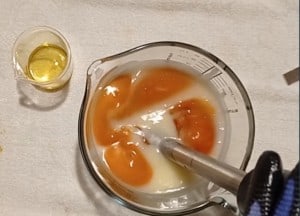
- Add the extract and essential oils after tracing. Mix well with a spoon.
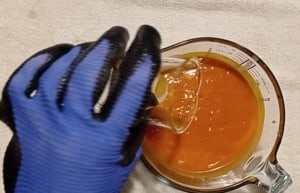
Molding and Curing
- Pour the dough in the molds with a pitcher and sprinkle with alcohol or witch hazel.
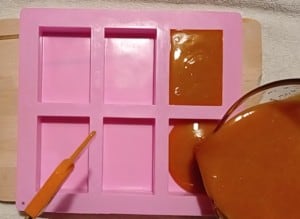
- Let it set for 48 hours.
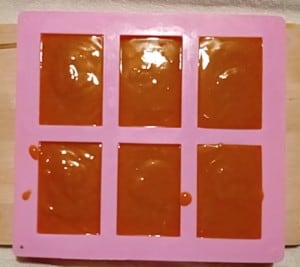
- Unmold and let the bars cure for 4 to 6 weeks. See How To Cure Soap.
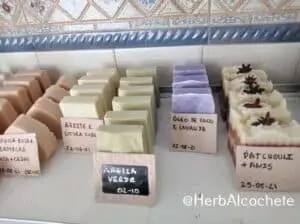
Video
